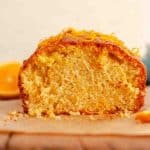
Easy Orange Loaf Cake
There's nothing quite like a homemade orange loaf cake. Moist, citrusy, and bursting with orange flavor.
Servings 8 -10
Equipment
- medium and large mixing bowls
- standard loaf cake pan
- parchment paper
- microplane or zester
- small saucepan
- whisk
- hand mixer
Ingredients
For the syrup
- ¼ cup (50g) sugar
- zest and juice from 1 orange (about ¼ cup/60ml juice)
For the cake
- 2 cups (250g) all-purpose flour
- 2 teaspoons baking powder
- ¼ teaspoon salt
- zest from 2 medium oranges about 2 ½ tablespoons
- 1 cup (200g) sugar
- ½ cup (113g) butter, at room temperature
- 3 medium eggs, at room temperature
- ¼ cup (60ml) fresh orange juice
- 2 tablespoons light vegetable oil
- 1 teaspoon vanilla
- ¼ cup (60ml) milk
Instructions
- Preheat oven to 350℉ / 180℃.
- Grease a standard loaf pan and line it with parchment paper with about 2-3 inches overhanging on the sides to use as handles. Set it aside.
Make the syrup
- In a small saucepan, add the sugar, zest and juice and cook on low heat and stir until sugar dissolves.¼ cup (50g) sugar, zest and juice from 1 orange
- Bring to a boil, then lower the heat and simmer it for 5 minutes (I use a timer). Set it aside to cool.
Make the cake
- In a large bowl, whisk the flour, baking powder and salt together. Set aside.2 cups (250g) all-purpose flour, 2 teaspoons baking powder, ¼ teaspoon salt
- In another bowl, rub the zest and sugar together with your fingers (or use a mixer). Set it aside.zest from 2 medium oranges, 1 cup (200g) sugar
- In another large bowl, cream the butter with a hand mixer for about 3 minutes until it’s soft and creamy.½ cup (113g) butter, at room temperature
- Add the sugar/zest mixture to the butter and beat for about 1-2 minutes, scraping the bowl frequently, as needed.
- Add the vanilla and the eggs, one at a time, beating on medium speed for about a minute after each addition. Scrape the sides of the bowl a few times until everything is incorporated.1 teaspoon vanilla, 3 medium eggs, at room temperature
- Add the dry ingredients, the orange juice, the oil and the milk alternately to the butter mixture (I like to do it in 2 batches). Beat on high speed until thoroughly combined, but don't overmix it.¼ cup (60ml) fresh orange juice, 2 tablespoons light vegetable oil, ¼ cup (60ml) milk
- Pour the batter into the prepared pan and bake for 50 minutes – 1 hour, or until a toothpick inserted in the middle comes out clean.
- Allow the cake to cool in the pan for 5 minutes and then use a toothpick or a wooden skewer to poke holes all over it without going all the way to the bottom, just go about ¾ of the way down.
- Spoon or pour the syrup over the cake.
- Then use the overhanging parchment paper to lift the cake out of the pan and place it on a wire rack to cool completely.
- Enjoy!
Notes
- Zest before juicing. I always zest the oranges first before juicing them. I really love using a microplane, but you could also use a zester. Make sure you don't grate the white part (pith) that's underneath the peel because it's very bitter.
- Use freshly squeezed orange juice. Fresh orange juice will give you the best flavor.
- Measure accurately. A digital scale will always give accurate results.
- Use room temperature ingredients. Using room temperature ingredients ensures they incorporate evenly into the batter, which results in a nice, smooth batter.
- Mix until just combined. Don't overmix the batter. Overmixing can make the cake dense and heavy.
- Poking holes the right way. When you use the toothpick or wooden skewer to poke holes in the cake, make sure NOT to go all the way to the bottom, just go about ¾ of the way down.
- Ovens vary. Since every oven is different, keep an eye on the cake while it's baking, especially during the last 10 minutes. A toothpick inserted in the center should come out clean when the cake is done.